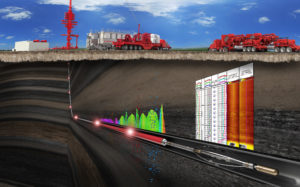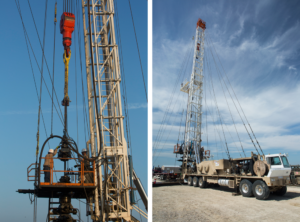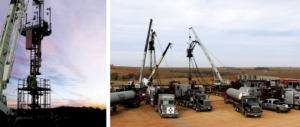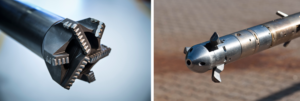Automated, integrated equipment, more powerful diagnostics and wireline renaissance boost intervention efficiency
By Katie Mazerov, Contributing Editor

As sure as the sun rises and sets each day, all oil and gas wells will, at some point, need an intervention to maintain or boost production. From basic drill-out and cleanout operations using wireline, coiled tubing or a snubbing unit, to full-scale workovers to remove and reinstall the wellhead to replace downhole equipment, well intervention is a fact of life in the oilfield. It is also becoming more critical as operators drill deeper and longer in hotter and more pressurized environments.
Equipment that is often automated and integrated, specialty services to meet the rigor of today’s well environments, new wireline applications, and powerful diagnostic tools that deliver a clearer understanding of what is happening downhole are increasingly in demand to meet a key priority for operators: efficiency.
In the US unconventional land market, large-diameter coiled tubing (CT) continues to be a well intervention mainstay – and is used extensively to drill out frac plugs. However, as laterals get longer and pressures rise, newer methods and technologies have emerged to not only enhance the performance of this ubiquitous intervention workhorse but also offer alternatives.
Fewer Assets to Drill Longer Laterals
“As operators strive to work within strict cash flow constraints and use fewer assets to drill longer laterals and gain more production in challenging environments, the well intervention sector is responding by focusing on greater efficiencies and enhancing equipment,” said Carlos Peña, Chief Strategic Officer for Pioneer Energy Services, which has expanded its drilling business since 2008 to include wireline, well servicing and CT capabilities.
- Focus is increasing on improving efficiency and enhancing intervention equipment to address longer laterals, higher pressures.
- Requirement for better hydraulics to clean out extended-reach wells in fewer trips is leading to a shift to large-diameter CT.
- Recent innovations aim to provide better diagnostic capabilities and improved efficiency in removing large volumes of sand, debris. Eagle Ford operators are also seeking high-temperature versions of intervention solutions.
Pioneer, which is active in most of the US shale basins, notably the Gulf Coast region, has 125 well servicing rigs that feature crown-out and floor-out devices, which promote safer operation of the traveling block. The rigs have taller derricks and are designed with work floors and driller’s platforms that can be raised up to 36 ft to accommodate the higher blowout preventer (BOP) stacks required for higher-pressure environments. The 550-600-hp class rigs include BOP safety controls and isolated and secondary BOP closing systems.

The company’s mix of completion and intervention wireline services provides a broad suite of services and expertise, Mr Peña contends. Remedial wireline intervention services include logging work – both cased and open hole – mechanical services, pipe recovery and slickline. A recent trend involves interventions resulting from well communication or frac hits. “In some mature plays with tighter well spacing, the fracturing of a new well can affect nearby mature wells, requiring the need to pull rods and tubing and clean out the well.”
Pioneer also operates five large-diameter CT units, including three in the Eagle Ford and two in the Rockies, and four 2-in. or smaller diameter units. “CT is like the Swiss Army knife of the oilfield in that it was designed to do remedial interventions in live wells using small-diameter pipe. Today it is one of the fastest ways to drill out plugs and clean out horizontal wells using large-diameter pipe,” he added.
“Operators have been testing the limits to determine the optimal lateral length,” he continued. “The data show that lengths have been increasing, with a healthy number of wells around 10,000 ft. Last year in Appalachia, we saw some laterals extend beyond 17,000 ft, with some in the 15,000- to 17,000-ft range. However, there is a point of diminishing returns when it comes to the risk and cost of drilling a three-mile lateral, where fixing problems is much more complicated and expensive.”
Shift to Large-Diameter CT
The shift to large-diameter CT, driven by the need for better hydraulics to clean out extended-reach wells in fewer trips and reciprocate pipe back to the heel of the vertical, has been dramatic. “In 2014, 2-in. or smaller CT accounted for over 70% of our business. Today, more than 70% of our business comes from 2 3/8-in. or larger pipe,” said Rob MacKenzie, Financial Analyst for Cudd Energy Services. The company operates in most US shale plays, including the Permian Basin, the Mid-Continent’s SCOOP/STACK play and the Marcellus and Utica plays in Appalachia.
“As lateral lengths increase, operators need to maximize every bit of production they can from unconventional wells by increasing the number of stages and tightening up stage spacing, which increases the number of plugs and the amount of proppant that needs to be cleaned out,” explained Chris Schneider, Sales Manager for Cudd.
Responding to that trend, the company has enhanced its existing CT equipment with pipe capacities to reach the extended lengths and is adding eight state-of-the-art 2 5/8-in. capable CT units this year. Cudd is also introducing automated, higher hydraulic horsepower pumps, equipped with systems that integrate the mixing plants with the fluid pumps, eliminating the need for additional personnel on site to handle and mix the chemicals required for cleanouts. “Fewer people on location enhances safety and streamlines the operation,” Mr Schneider said.
However, with material makeup and string designs being stretched to the limit and highway weight restrictions on the legal transport of large reels with 25,000 ft or more of CT, there is also a growing preference for workover rigs and snubbing units. These rigs use traditionally jointed pipe not limited by a fixed reel size, with larger sizes – as large as 2 7/8 in. – more easily transportable by truck, he explained.
Cudd also has a fleet of five standalone and nine rig-assist snubbing units for drilling out plugs while keeping the well live or underbalanced with minimal formation damage versus a workover rig. “By managing the pressure with a snubbing unit, we can allow the well to flow to aid in the cleanout, as well as prevent formation damage by not killing the well,” Mr Schneider said.

To meet growing demand for operational efficiency and safety in the longer laterals, the company will add one new quick-jack standalone snubbing unit this year and plans to upgrade the capability of two other standalone units by incorporating greater automation and equipment components that will facilitate faster connections and less breakage of connections. “Safety is key to everything we do,” Mr MacKenzie noted. “Our customers value our safety and environmental record as highly as we do because it’s good business.”
Cudd offers special services such as gate-valve drilling, wellhead freezing and hot tapping services, for remediation of surface and wellhead equipment to either repair a wellhead problem or alleviate trapped pressure, Mr Schneider said.
Enhancing Diagnostics for Efficiency
In a move to help meet industry demand for efficiency, reliability and subsurface insight to maximize asset recovery, Halliburton enhanced the diagnostic capabilities of the SPECTRUM Real-Time Coiled Tubing Services portfolio with the October 2018 release of SPECTRUM 360 Service. It is a real-time, high-resolution, flow-through camera with a full 360° field of view. The camera pairs with the SPECTRUM FUSION service, which combines fiber-optic and electric conveyed through CT to provide continuous power and real-time telemetry using wireline or mechanical intervention tools to customize a variety of intervention and diagnostic applications.
“This specialized camera provides direct visualization in downhole applications, allowing us to physically observe what is happening in the wellbore, helping to better understand operating parameters and make important decisions on the fly during the job, rather than rely on surface data,” explained Eric Bivens, Global Technical Advisor. “We can accurately diagnose wellbore issues, such as split collars, and verify that services, such as shifting sleeve applications, have been achieved, benefitting overall efficiency.”
The camera has been run in test wells in Oklahoma and is in the planning stages for broader implementation in the North American market for applications such as perforation cluster inspection, together with temperature and acoustic profiling. “Camera inspection allows better understanding of cluster efficiency, frac initiation points and the ability of diverters to provide homogeneous treatment,” Mr Bivens said.
SPECTRUM Services, which has been deployed in 14 countries, has seen rapid expansion in North America, including the Bakken, Permian Basin and the Eagle Ford, where operators are looking to enhance the capabilities of conventional or remedial CT services with diagnostics in order to optimize overall well operations, he noted. “With these added capabilities, we can combine a larger number of service applications in fewer runs, often integrating CT and wireline applications in the same run. We have more direct control over the tools, we know exactly what is happening with the bottomhole sensors, and we can acquire vast amounts of downhole data in real time. Importantly, with various offering levels, we can customize services to an operator’s specific needs. Wellbore issues can be variable and are resolved with the help of customized solutions.”
For example, the SPECTRUM FUSION assembly has a casing collar locator and gamma ray sensor for improving the depth accuracy of CT to better target perforations or chemical treatments, Mr Bivens said. For plug millouts, the system provides torque and weight-on-bit readings to help prevent stalling. “In the Bakken, the system has proved beneficial in providing distributed and acoustic profiling to improve well completion strategies and shrink the learning curve.”
The platform was designed with an open architecture interface that can be paired with mechanical or electrical tools on the market. Halliburton continues to expand the SPECTRUM Services portfolio and this year plans to introduce two add-ons to address key intervention challenges, he added.
Capturing Wellbore Debris
Efficiency in safely removing large volumes of sand and other debris from wellbores is an issue common to the US market. It was the driver for Baker Hughes, a GE company (BHGE), to expand applications of the Vectored Annual Cleaning System (VACS) in 2017. Available in 2 7/8-in. to 10-in. sizes, the service can be run more than 4,000 ft, typically deployed by utilizing a small workover rig and tubing on location. Fluids are pumped conventionally, but the system generates a reverse-circulation flow through a nozzle, capturing debris and transporting it to the surface in a single trip.

The modular system, which is adaptable for various applications, requires no specialized rigging equipment, operates without mechanical movements or ball drops and is deployed in all major US basins to remove sand and hard iron sulfide debris and clean wells. BHGE anticipates using the service for long lateral plug-milling, using the company’s plug-milling technologies.
“Effectively removing debris can reduce subsequent interventions with fewer maintenance intervals to pumps and the total wellbore, reducing operational costs,” said Joeri Van Hove, Global Product Line Manager, Well Intervention-Wellbore Cleanup. “Oftentimes, formation or frac sands flow into the completion and plug up the perforations, reducing wellhead pressure, or cause surface pumps to fail, reducing bottomhole pressures and inhibiting production.” The system also performs in wells with a very low fluid column that can’t lift debris to the surface.
Job planning is supported by the VACSPREdictor software, which simulates downhole conditions to determine optimum operating parameters, including flow rates and pressure. “Changes in downhole conditions can be input immediately to make necessary adjustments to ensure the most effective cleanout,” Mr Van Hove said.
In 2018 in Colorado’s Denver-Julesburg basin, simulations determined the proper flow rates to remove debris in a depleted horizontal completion where sand production had caused two pumps to fail within a month. The 2 7/8-in. VACS systems was run with 1,000 ft of tubing to clean 3,960 ft of debris from the well heel into the lateral. Following the cleanout, the well was put back online with a pump, and production increased from 16 bbl/day to 50 bbl/day. VACS extended pump life by more than nine months.
The system is deployable with CT, and this approach is often initially selected for high-profile wells with an existing CT footprint, although there are limitations with the coil’s inability to rotate, as well as the lubricator length, Mr Van Hove noted. “Pumping alone is often not sufficient because the sand has a hardened surface that must be broken down, typically with a 30-40 RPM power swivel on the rig.

“VACS is ideal for the large number of small, independent operators in the US that don’t have an expensive CT unit but want an effective solution,” he continued. “Natural lift, which is hard on pumps, and bailing techniques, which involve running in underbalanced with a tool and dropping a ball or rupture disk to allow the tool to capture and bring fluid and debris to the surface, are economical alternatives, but they are not very efficient.”
Wireline Intervention Renaissance
Continued focus on cost reduction and improving recovery has also inspired new applications for Welltec’s suite of solutions, long used for horizontal well intervention. “This is especially the case in high-temperature environments and wells with harsh stimulation fluids and increasingly longer laterals,” said Sid Kittur, Vice President, US and Trinidad & Tobago.
The downturn and subsequent recovery sparked a “wireline intervention renaissance” in the US land market in the past 18 months, including tractor-conveyed plug milling, tubular cutting and debris-cleaning solutions, he noted. “Our equipment and personnel can be rapidly mobilized and rigged up for unplanned interventions, and the small operating footprint typically requires minimal reconfiguration of heavy equipment on a multiwell pad. This reduces cost and NPT directly associated with any intervention and allows the operator to simultaneously continue stimulating other wells.”
Welltec is active in all unconventional US basins. In the Permian, the company’s NACE-compliant equipment is effectively managing the high concentration of acid commonly present in stimulation fluid, while operating temperatures exceeding 300°F are a common issue in the Eagle Ford.
“In the Eagle Ford, customers are routinely asking for high-temperature versions of our intervention solutions. We are responding with multiple engineering projects to extend the temperature range of our technologies to meet those customer requests but also to allow us to target other warmer plays in the US,” Mr Kittur said. “The trend toward longer, extended-reach laterals in the high-temperature Bakken also represents a major technical challenge to conventional interventions.”
A key technology Welltec has introduced to the US market is the Well Miller RCB (Reverse Circulating Bit), a ready-on-arrival plug milling service that has been used to mill prematurely set frac plugs and clean out cement stringers in longer horizontals. Another is the Well Cleaner PST (Power Suction Tool) used to remove sand and other completion debris from the wellbore.
To further expand cleaning capabilities, Welltec recently introduced a dry gas, sand bailing tool with nozzles that prevent collection of debris and minimize sticking risk. “This will boost the effectiveness of cleanouts of sand, plug remnants and other debris in dry gas environments, such as the Marcellus, where sanding of dry gas wells is a significant challenge,” he said.
Once cleaning has been performed, subsequent operations typically include some type of mechanical intervention within the well. The 2.375-in. mechanical Well Cutter is seeing increased deployment in the trending mechanical isolation refrac market in the Eagle Ford as an alternative to chemical diverters. “Operators are running smaller-size casing inside the existing completion and cementing it in place. This cutting tool cleanly cuts 4-in. casing with a smooth bevel, allowing deployment of guns and plugs through the cut, while limiting damage to the original casing behind it,” Mr Kittur explained. The 5.75-in. Well Cutter, introduced in 2018, extends the operating range from 2.875-in. to 9.625-in. tubulars. DC




